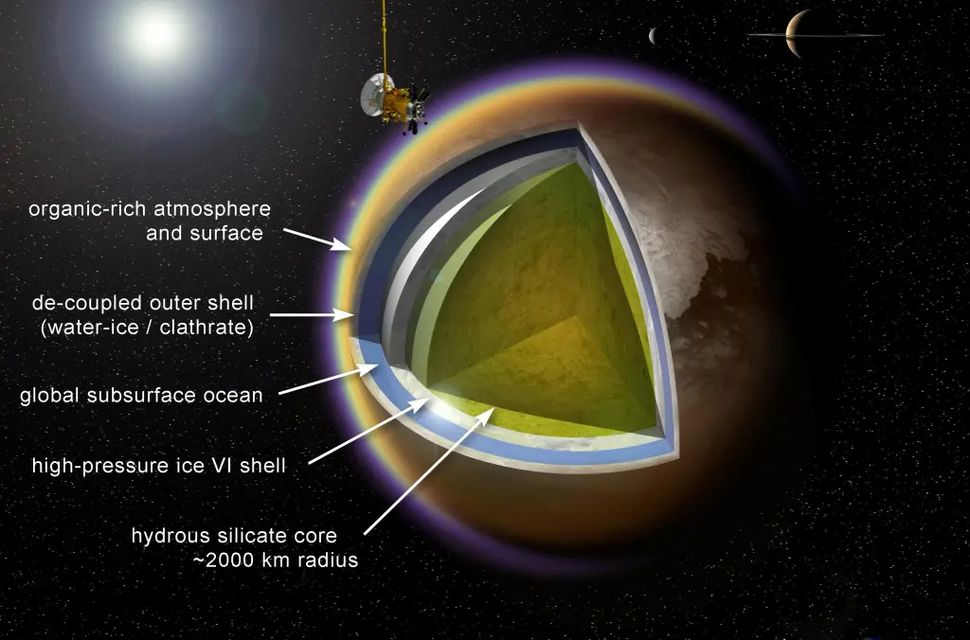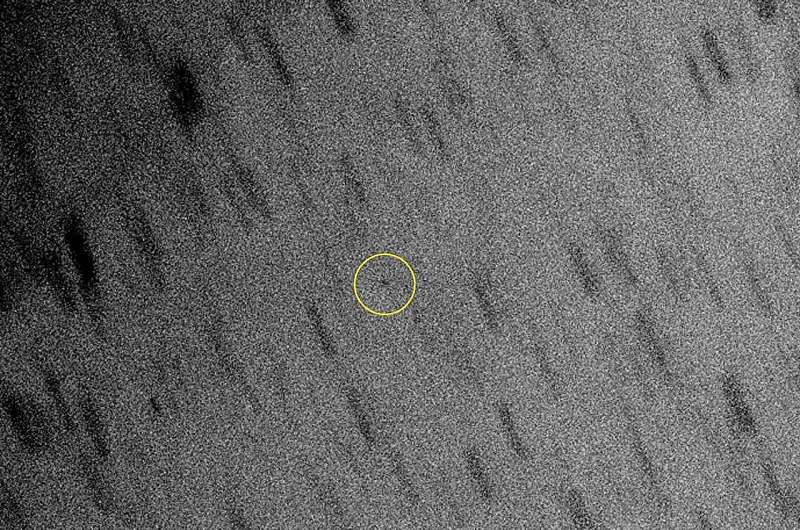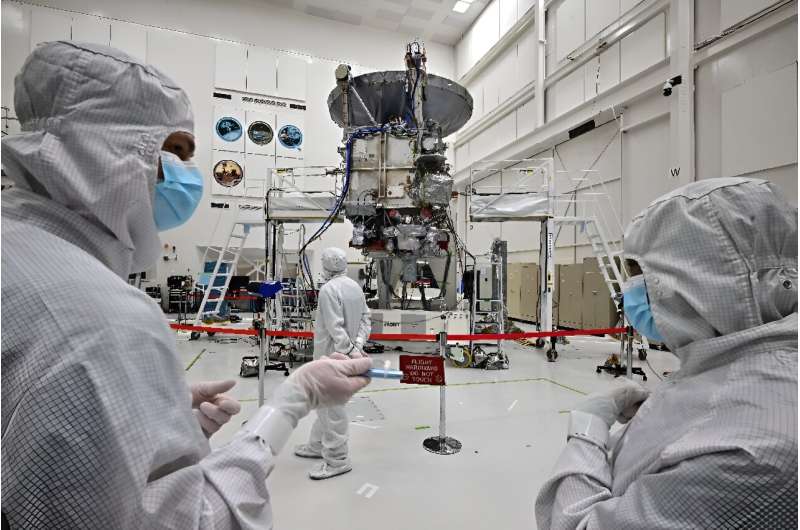Exploration of the gas giants
-
weatheriscool
- Posts: 13586
- Joined: Sun May 16, 2021 6:16 pm
Re: Exploration of the gas giants
I'd bet money that some form of life lives on one or more of the half dozen under ice oceans on the moons of the giant planets in our solar systems. I find it highly unlikely that life is on Mecury, Venus or mars...It just makes sense in these massive oceans that are 10-100 times the water volume of our planet oceans with this kind of tidal forcing that something could have sprung up.
If I was in charge of finding life I'd look at these half dozen + moons and fund sub missions to them.
If I was in charge of finding life I'd look at these half dozen + moons and fund sub missions to them.
-
weatheriscool
- Posts: 13586
- Joined: Sun May 16, 2021 6:16 pm
Re: Exploration of the gas giants
Stunning Juno flyby image shows Io lit up by "Jupitershine"
By David Szondy
February 08, 2024

By David Szondy
February 08, 2024

https://newatlas.com/space/juno-flyby-i ... itershine/NASA has released a high-resolution image taken by the Juno deep space probe during its close encounter with Jupiter's moon Io on December 30, 2023. The image of the volcanic satellite not only shows remarkable details, but an usual kind of lighting.
When the robotic Juno orbiter zoomed past Io in December, it was the closest flyby of the moon since the Galileo mission over 20 years ago. It also marked a generational jump in photographic capability thanks to its JunoCam, which can manage a resolution of 15 km/pixel (9.3 miles/pixel) from 4,300 km (2,700 miles).
As Juno passed over the southern hemisphere of Io, JunoCam sent back high-resolution images of many of the moon's features, including active volcanoes spewing clouds of sulfur into space.
- Time_Traveller
- Posts: 2234
- Joined: Sun May 16, 2021 4:49 pm
- Location: San Francisco, USA, June 7th 1929 C.E
Re: Exploration of the gas giants
Saturn's ocean moon Titan may not be able to support life after all
https://www.space.com/titan-ocean-satur ... arth-studypublished about 17 hours ago
Titan's underground ocean, and similar oceans inside other icy moons in the outer solar system, may lack the organic chemistry necessary for life, according to new astrobiological research.
Titan is Saturn's largest moon, and the second largest moon in the entire solar system. It's famous for being shrouded in a smog of petrochemicals and for possessing a veritable soup of organic molecules — molecules that contain carbon — on its surface. Yet, despite all this fascinating chemistry, Titan is cold. Very cold. It has surface temperatures no warmer than –179 degrees Celsius (–290 degrees Fahrenheit). And in these frigid conditions, chemical reactions for life progress very slowly.
However, deep underground where it's warmer — the exact depth is not certain, but estimates suggest it's on the order of 100 kilometers (62 miles) — a liquid ocean with a volume 12 times that of Earth's oceans combined is thought to exist. Similar oceans inhabit the interiors of Titan's fellow Saturnian moon Enceladus, and Jupiter's moons Europa and Ganymede.
And where there is liquid water, there could be life. Right? Not so fast, says Catherine Neish of Western University in Ontario, Canada.
A planetary scientist, Neish led an international team that challenged the assumption Titan's ocean, and indeed the oceans of other icy moons, could be habitable.
"We all have our time machines, don't we. Those that take us back are memories...And those that carry us forward, are dreams."
-H.G Wells.
-H.G Wells.
- Time_Traveller
- Posts: 2234
- Joined: Sun May 16, 2021 4:49 pm
- Location: San Francisco, USA, June 7th 1929 C.E
Re: Exploration of the gas giants
3 tiny new moons found around Uranus and Neptune — and one is exceptionally tiny
https://www.space.com/new-moons-discove ... us-neptuneabout 16 hours ago
Astronomers have discovered two tiny moons orbiting Neptune and one circling Uranus, bringing the number of their known moons to 16 and 28 respectively.
Uranus' new moon, the first detected around the ice giant in over two decades and possibly the smallest of its ilk, is just 5 miles (8 kilometers) wide; it takes 680 days to complete one orbit around Uranus. In comparison, one Mars' moons named Deimos, considered to be among the tiniest known moons in our solar system, is 8 miles (13 km) wide.
The new moon of the blue-green planet is currently referred to as "S/2023 U1" while it awaits being named for a Shakespearean character, according to a statement by Carnegie Institution for Science (or Carnegie Science).
The brighter of Neptune's two new moons is provisionally named "S/2002 N5." At 14 miles (23 km) wide, this newly discovered satellite seems to be in a 9-year orbit around Neptune. The fainter moon, currently assigned the name "S/2021 N1," is 8.6 miles wide (14 km) and circles Neptune once every 27 years. Both Neptunian moons will be assigned permanent names based on sea gods and nymphs in Greek mythology.
"We all have our time machines, don't we. Those that take us back are memories...And those that carry us forward, are dreams."
-H.G Wells.
-H.G Wells.
-
weatheriscool
- Posts: 13586
- Joined: Sun May 16, 2021 6:16 pm
Re: Exploration of the gas giants
Subaru Telescope discovers the faintest moon around icy giant planets
https://phys.org/news/2024-03-subaru-te ... n-icy.html
by Subaru Telescope
https://phys.org/news/2024-03-subaru-te ... n-icy.html
by Subaru Telescope
Using some of the largest telescopes in the world, including the Subaru Telescope, a team of astronomers discovered three new natural satellites orbiting the outermost planets in our solar system—one around Uranus and two around Neptune. One of the new moons, initially detected by the Subaru Telescope, is the faintest moon ever discovered by ground-based telescopes.
"The three newly discovered moons are the faintest ever found around these two ice giant planets using ground-based telescopes," explains Scott Sheppard (Carnegie Institution for Science), who leads the research.
The new moon around Uranus, S/2023 U1, increases the total number of known moons orbiting the ice giant planet to 28. Initially detected using the Magellan Telescope in Chile in 2023, it was subsequently confirmed in earlier images captured by the Subaru Telescope and Magellan Telescope in 2021. With a diameter of just 8 kilometers, it is likely the smallest among Uranus' moons. It completes one orbit around the planet in 680 days.
-
firestar464
- Posts: 831
- Joined: Wed Oct 12, 2022 7:45 am
Re: Exploration of the gas giants
Scientists use James Webb Space Telescope to uncover clues about Neptune's evolution
https://phys.org/news/2024-03-scientist ... scope.html
https://phys.org/news/2024-03-scientist ... scope.html
-
weatheriscool
- Posts: 13586
- Joined: Sun May 16, 2021 6:16 pm
Re: Exploration of the gas giants
NASA unveils probe bound for Jupiter's possibly life-sustaining moon
https://phys.org/news/2024-04-nasa-unve ... piter.html
by Huw GRIFFITH
https://phys.org/news/2024-04-nasa-unve ... piter.html
by Huw GRIFFITH
NASA's Europa Clipper Spacecraft is headed for one of Jupiter's moons to see if it has the right conditions to sustain life.
US space scientists on Thursday unveiled the interplanetary probe NASA plans to send to one of Jupiter's icy moons as part of humanity's hunt for extra-terrestrial life.
The Clipper spacecraft is due to blast off in October bound for Europa, one of dozens of moons orbiting the solar system's biggest planet, and the nearest spot in our celestial neighborhood that could offer a perch for life.
"One of the fundamental questions that NASA wants to understand is, are we alone in the cosmos?" Bob Pappalardo, the mission's project scientist told AFP.
"If we were to find the conditions for life, and then someday actually find life in a place like Europa, then that would say in our own solar system there are two examples of life: Earth and Europa.
-
weatheriscool
- Posts: 13586
- Joined: Sun May 16, 2021 6:16 pm
Re: Exploration of the gas giants
Unraveling water mysteries beyond Earth: Ground-penetrating radar will seek bodies of water on Jupiter
https://phys.org/news/2024-04-unravelin ... ating.html
by European Geosciences Union
https://phys.org/news/2024-04-unravelin ... ating.html
by European Geosciences Union
Finding water on distant planets and moons in our solar system is a challenge, especially when the instrument is thousands of kilometers away from the surface, but scientists presenting at the European Geosciences Union General Assembly describe how ground-penetrating radar is used to discover bodies of water below the surface of distant planets and they are on their way to Jupiter.
The first clue for finding life on other planets is finding liquid water. The moons of Saturn and Jupiter like Enceladus, Ganymede, Europa, and Callisto are suspected of holding oceans of liquid water beneath icy crusts. Similarly, some exoplanets beyond our solar system likely host liquid water, crucial for habitability. But detecting water, when we can't physically access these celestial bodies, poses challenges. Ice-penetrating radar, a geophysical tool, has proven capable of detecting liquid water on Earth and beneath Mars' South polar cap.


